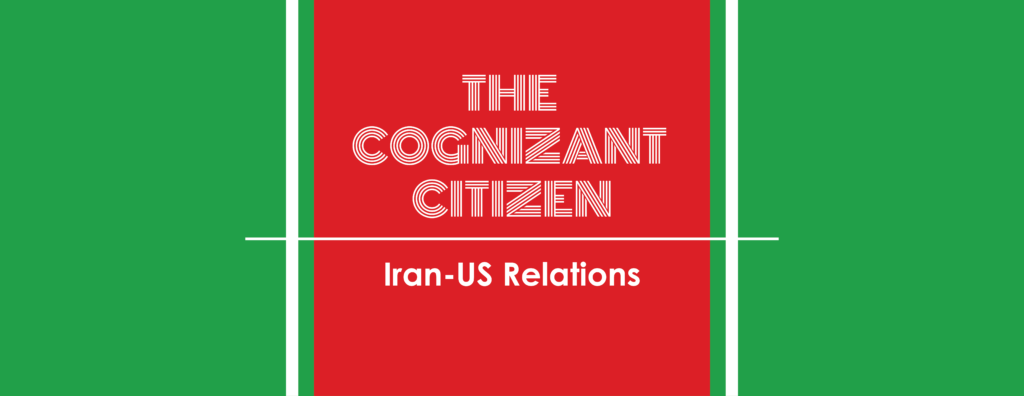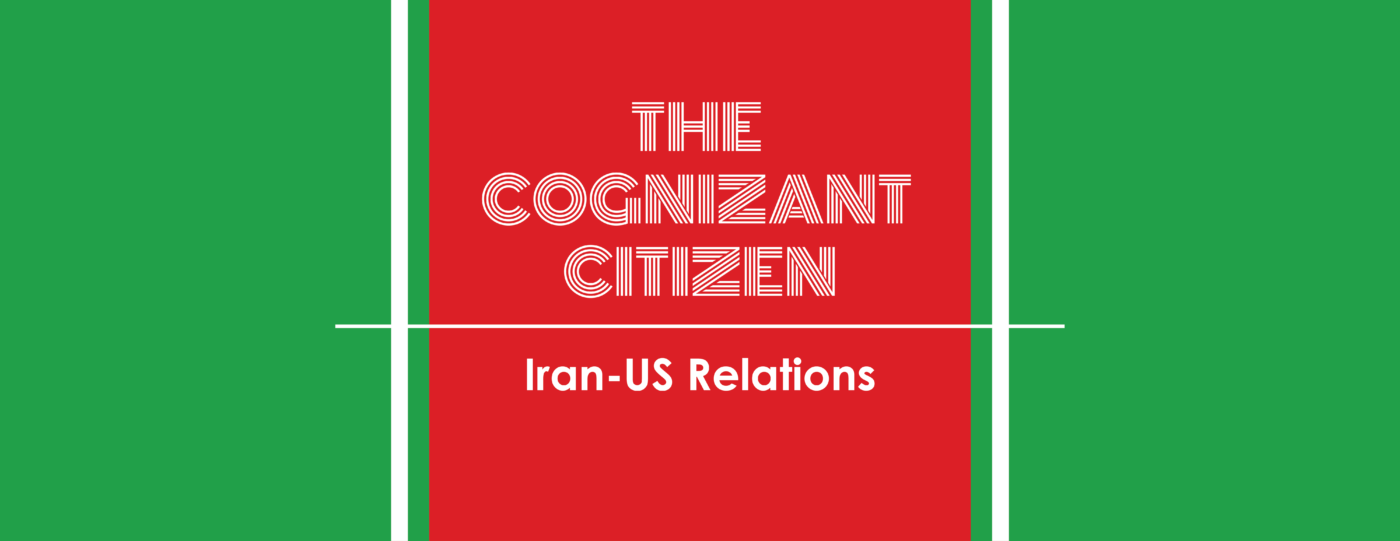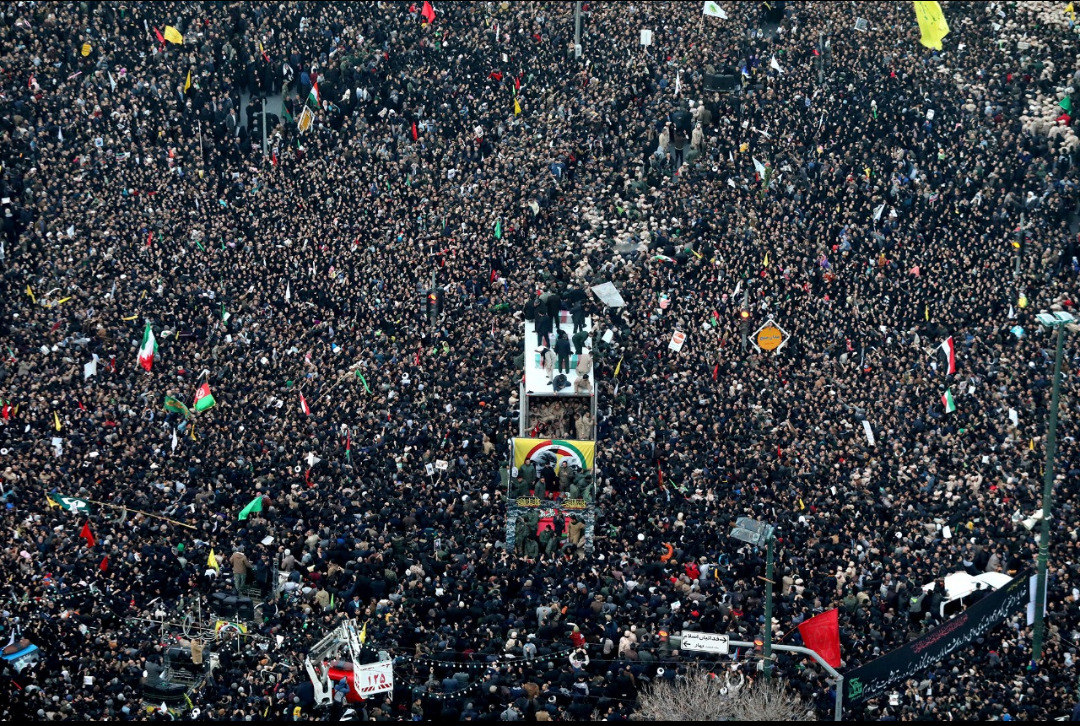
Tensions between Iran and the U.S skyrocketed to an unprecedented level after the U.S President Donald Trump approved an airstrike in Baghdad on Friday killing Qassem Soleimani. Considered to be the most powerful Iranian military commander, the news of his death garnered the world’s attention. Generating analyses about the implications of the act, some fear an all-out war while others deny its possibility.
This deadly plan came to fruition after a series of hostile occurrences in the last year, which further increased the tensions between the two countries.
HOW DID THE SITUATION ARISE?
The relations between Iran and the U.S have been strained for decades– ever since the 1953 coup that was engineered by the United States and the United Kingdom. It overthrew the then democratically elected Prime Minister Mohammad Mosaddegh and brought Iran back to a monarchic rule by putting the Shah (Emperor) in power. Its primary motive was to prevent Mosaddegh from nationalising the Iranian oil industry which was previously controlled by the British. Denying involvement up till 2013, the Central Intelligence Agency of the U.S ultimately acknowledged its role in the coup.
The animosity towards the Americans in the minds of many Iranians can find its roots in this act. It was also perpetuated by the subsequent oppressive nature of the Shah’s regime under the influence of the powers in the West, which culminated in the Iranian revolution of 1979.
THE IRANIAN REVOLUTION,1979
Under the schemes of the Shah, a rapid transition from a traditional society into a pro-Western model of urbanisation took place. Economic hardships emerged due to corruption or concentration of wealth among a select few. This led to growing dissent among various groups of Iranians. Increasing censorship and surveillance of voices raised against the functioning of the government further fuelled the revolution that would ultimately end monarchy in the country. The protesters gradually came under the influence of a spiritual and religious leader, Ayatollah Ruhollah Khomeini. He was publicly opposed to the Shah’s close ties with the U.S, for which he had been even sent to exile. With him leading the movement and eventually achieving success, the nation was then put under a theocratic government and the Islamic Republic of Iran was formed in April 1979.
Khomeini was made Supreme Leader, the head of state with political and religious authority. As a reply to the US accepting the Shah into their country for his health treatment, he had extended his support to the Iranian students who had occupied the American embassy in Tehran later in the year. They had held a number of American officials hostages who had finally been released after 444 days. This led the U.S to start the first of its series of sanctions. All thoughts of diplomatic relations between the two countries then came to an end. Since then, Switzerland protects the interests of the United States in Iran while Pakistan does the same for Iran.
The United States also reportedly aided Iraq with military support and intelligence data in the Iran-Iraq war (1980-1988), which obviously did nothing to resolve the growing complicated matters.
SITUATION IN THE MIDDLE EAST
Bearing witness to extremely fragile international relations, the Middle East has long been a zone of contention. Majorly consisting of Islamic countries, there is a consistent split between the Shia and Sunni dominated countries which is the root of various conflicts. The US has sought to establish a strong presence in the region mainly for the purposes of propagating free oil flow for its use, restricting nuclear power and fighting terrorism.
The US has found strong allies in Israel and Saudi Arabia and opposes those who harm their interests.
Iran, which has a Shia majority, has ongoing conflicts with both of these countries – because of Saudi Arabia’s Sunni power and Israel’s democracy which has a majoritarian Hebrew population.
A notable point of contention resides in Syria. Although it’s primary objective is to fight the rise of the terrorist militant group ISIS in the region, the US has also been deeply involved in the Syrian Civil War. It is said to support the rebel groups who oppose the Syrian authoritative government wherein the al-Assad family of the socialist Ba’ath party exercise maximum power. Meanwhile, Iran has provided assistance to the Syrian government which includes logical and military support. Iran’s support for groups that are deemed by the US as ‘terrorist organisations’ such as Hezbollah in Lebanon is also strongly condemned by the US. It is a Shia Islamist military group, receiving support by Iran.
JOINT COMPREHENSIVE PLAN OF ACTION
Concerned about the utilisation of the nuclear power in Iran to build harmful weapons, the major powers of the world such as the UN, the US and the EU imposed sanctions on Iran. These were implemented in an attempt to force the country to curb the enrichment of uranium. These sanctions restricted international trade and damaged Iran’s economy, leading to soaring costs of living and worsening conditions for the people.
Under Rouhani’s presidency, Iran made a nuclear deal with six major countries (US, UK, Russia, France, China and Germany) in 2015. The former President of the US, Barack Obama, highly stressed its importance and considered it to be a huge achievement. The deal, known as the Joint Comprehensive Plan of Action, provided relief of sanctions in Iran in exchange for allowing supervised restrictions on major parts of the Iranian nuclear programme.
RELATIONS UNDER THE TRUMP ADMINISTRATION
The nuclear deal provided only temporary ease as things particularly took a drastic turn when U.S President Donald Trump pulled out of the deal in 2018. It was not entirely shocking as he had expressed his disapproval of it on countless occasions. It was even a part of his campaign promises. The strategy of applying ‘maximum pressure’ on Iran thus came into effect, imposing sanctions on Iran in full measure. Although it doesn’t mean that the deal is completely broken as other countries are also included in it, it paved the way for Iran to ultimately announce on Jan 5th, 2020 that it will no longer abide by the rules of the deal.
There were increased fears that the Iranian military posed threats to the US people and leaders. In April 2019, the US designated the Islamic Revolutionary Guard Corps (IGRC), a part of the Iranian Armed Forces, as ‘a terrorist organisation’. Consequently, multiple allegations and attacks took place involving the two countries. The US has accused Iran of being behind the attacks in the summer of 2019 which damaged oil tanks and commercial ships in the Gulf of Oman and surrounding regions. Being a strategically important location for oil trade, any major incident has the potential to affect the world’s economy. This reportedly engendered the US to send additional troops to the region.
A US drone was shot down by the IRGC, based on their claim that it was travelling over the Iranian region. The proposed retaliatory attacks were called off at the last minute by the Trump administration.
On December 27 2019, a barrage of Katyusha rockets was launched on an Iraqi military compound in Kirkuk. A United States defence contractor was killed and several Iraqi troops were wounded. According to officials, up to thirty rockets were launched.
The U.S. blamed Kataeb Hezbollah for the attack, an Iraqi militia backed by Iran; and subsequently conducted so-called “precision defensive strikes” against five sites of the militia, three in Iraq and two in Syria. This included weapons depots and the militia’s command and control bases. Kataeb Hezbollah is a part of a group of state-sanctioned militias known as the Popular Mobilization Forces. According to the Popular Mobilization Forces, nineteen of their members were killed.
The Iraqi government strongly criticized the move, calling the strike a “dangerous violation” of its sovereignty. On December 31, angry militiamen protested by violently breaking into the U.S. Embassy in Baghdad, smashing doors and setting parts of it on fire, in what was considered one of the worst attacks on the Embassy in recent history.
Following this, the U.S. launched a drone strike on the Baghdad airport on January 3. General Qasem Soleimani was killed in the strike along with other powerful military officials. Leading Iranian military operations in the Middle East, he was considered to be the second-most powerful man in Iran, behind their Supreme Leader Ayatollah Ali Khamenei.
Soleimani was widely regarded as a national hero in Iran. He was the commander of the 41st Tharallah Division of the Islamic Revolutionary Guard Corps (IRGC) during the Iraq-Iran War in the 1980s. He became commander of the Quds Force of the IRGC in the late 1990s. Promoted to Major General in 2011, he was described as “the single most powerful operative in the Middle East.”
While leaders and citizens from other countries had varied opinions on Soleimani, he was widely loved and respected by his countrymen. According to a poll conducted by the University of Maryland School of Public Policy, Soleimani was viewed favourably by 82% of Iranians. He was seen as the personification of Iranian power by nationalists.
His death affected the entire nation as the three days following his death were declared days for mourning. Over a million people attended his funeral procession on January 5 in Tehran.
At least 56 people were killed and over 200 were injured in a stampede during his burial in Kerman on January 8.
According to the U.S. Defence Department, Soleimani was involved in approving the attacks on the U.S. Embassy, and “was actively developing plans to attack American diplomats and service members in Iraq and throughout the region.” The Pentagon released a statement justifying the strike by saying that it was “aimed at deterring future Iranian attack plans.”
INTERNATIONAL RESPONSE
Following the attack, Iran’s Foreign Minister, Javed Zarif called it an “act of international terrorism” and said that “the U.S. bears responsibility for all consequences of its rogue adventurism.” Iranian President Hassan Rouhani said that “Iran and the other free nations of the region will take revenge for this gruesome crime from criminal America.”
In the American Parliament, however, opinions were divided. Democrats criticized the move, calling it “dangerous escalation.” Republicans widely supported the strike. President Donald Trump vowed to “attack 52 sites in Iran” if it retaliates.
Russia called the attack a “murder” and a “reckless step”. Iraq condemned the strike, calling it an “assassination.” Syria called it “treacherous American aggression.”
Israel supported the move, praising President Trump for acting “swiftly, forcefully, and decisively.” Canada said that Soleimani’s “aggressive actions had a destabilising effect in the region and beyond.” France, Germany, and the U.K. released a joint statement saying “there is an urgent need for de-escalation” and called for all parties to “exercise utmost restraint.”
France’s deputy foreign minister said, “We are waking up in a more dangerous world.” Italy, Saudi Arabia, Brazil, Afghanistan, Qatar, and the U.A.E. all expressed concern for the increasing tensions and called for restraint in military actions.
On January 6, Iran announced “a tenfold increase in its enriched uranium production.” This was followed by a statement from President Trump on January 8 saying that the U.S. would impose “powerful sanctions” until “Iran changes its behaviour.”
As we continue to evaluate options in response to Iranian aggression, the United States will immediately impose additional punishing economic sanctions on the Iranian regime. These powerful sanctions will remain until Iran changes its behaviour.
—Donald Trump
The hours following the strike saw the topic of World War III trending on social media around the world. Iran has more military capabilities than any other country the U.S. has gone to war with since World War II. However, the possibility of it actually happening is far lesser than what it appears. Despite being opposed to the American strikes, Russia and China do not seem to want to join the fight outright, as evidenced by the U.S. invasion of Iraq, or the toppling of the Libyan government, or the Afghanistan war.
The days following up to the deadly airstrike witnessed violent attacks by both the US and the Iran-backed military groups in Iraq. The US had launched more airstrikes that killed several military men, while the US Embassy in Iraq was bombarded with protests and demonstrations. Iran shot down a Ukrainian passenger jet on 11 January, killing 176 people on board. Iran provided an explanation, saying that it had taken a turn toward “a sensitive military centre”, and the flight was hit “in an unintentional way and due to human error.”
Iraq, who has wished to sustain friendly relations with both Iran and the US, seemed to become embroiled in the situation. However, many Iraqis are now opposed to any foreign presence in the region as they pose a potential problem for the country’s stability.
—Written by Rushil Dalal and Tulika Somani for MTTN
— Featured image by Ansh Bhagania for MTTN
—Sources: BBC, CNN, Al Jazeera
—Image sources: Google images



Leave a Reply
You must be logged in to post a comment.